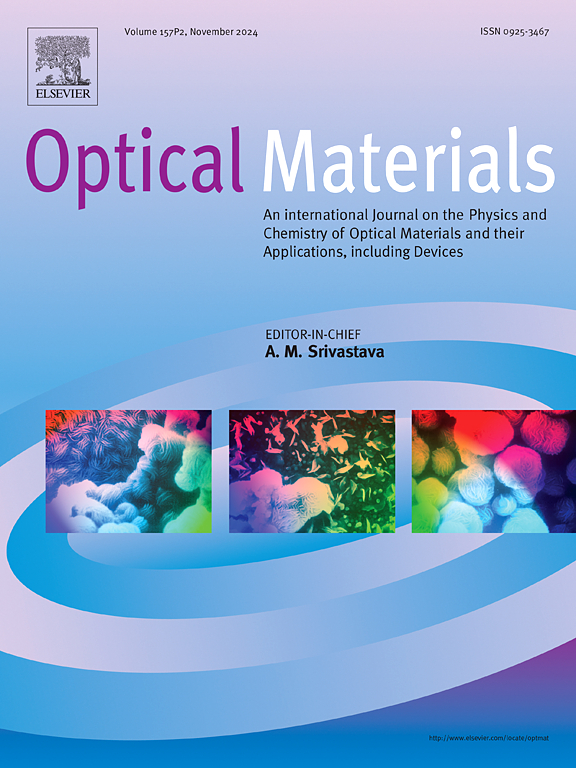利用有机配体合成用于激光和光电应用的白光发射混合镧系配合物
IF 3.8
3区 材料科学
Q2 MATERIALS SCIENCE, MULTIDISCIPLINARY
引用次数: 0
摘要
利用溶剂辅助研磨法合成了一系列混合络合物 [EuxTb1-x.L3]。配合物的化学成分是通过元素分析确定的。能量色散 X 射线分析(EDAX)用于确定配合物的纯度。利用扫描电子显微镜(SEM)和 X 射线粉末衍射(XRD)研究了合成复合物的形态和性质。研究了光致发光激发(PL)和光致发光发射(PLE)光谱与 Eu3+ 和 Tb3+ 离子浓度的函数关系,以预测溶液和固体两种状态下颜色的调整。热重数据分析显示,这些复合物具有良好的热稳定性,可用于生产有机发光二极管。计算了辐射率(Arad)、量子效率(φ)和 JO 强度参数(Ωλ)。研究这些复合物的厄巴赫能、光带隙和折射率表明,它们有望应用于半导体和太阳能电池装置。从复合物的发射光谱中可以获得 1931 年国际照明委员会(CIE)坐标 (x,y),这表明通过改变 Tb3+ 和 Eu3+ 离子的浓度,可以将颜色调整到接近白光(x = 0.3201,y = 0.3319)。本文章由计算机程序翻译,如有差异,请以英文原文为准。

Synthesis of white light emanating mixed lanthanide complexes with organic ligand for laser and optoelectronic applications
A series of mixing of complexes [EuxTb1-x.L3] was synthesized using the solvent-assisted grinding method. The chemical composition of complexes is determined by elemental analysis. Energy dispersive X-ray analysis (EDAX) was applied to ascertain the purity of complexes. The morphology and nature of the synthesized complex were investigated using scanning electron microscopy (SEM) and X-ray powder diffraction (XRD). The photoluminescent excitation (PL) and photoluminescent emission (PLE) spectra were examined as a function of the concentration of Eu3+ and Tb3+ ions to predict the tuning of color in both state solution and solid. Thermogravimetric data analysis reveals that these complexes have good thermal stability, supporting their application in producing organic light-emitting diodes. The radiative rate (Arad), quantum efficiency (φ), and JO intensity parameters (Ωλ) were calculated. Studying these complexes' Urbach energy, optical band gap, and refractive index suggests their potential application in semiconductor and solar cell devices. The Commission International de I'Eclairage 1931 (CIE) coordinates (x,y) can be obtained from the emission spectra of complexes, indicating that color can be adjusted to nearly white light (x = 0.3201,y = 0.3319) by changing the Tb3+ and Eu3+ ion concentrations.
求助全文
通过发布文献求助,成功后即可免费获取论文全文。
去求助
来源期刊

Optical Materials
工程技术-材料科学:综合
CiteScore
6.60
自引率
12.80%
发文量
1265
审稿时长
38 days
期刊介绍:
Optical Materials has an open access mirror journal Optical Materials: X, sharing the same aims and scope, editorial team, submission system and rigorous peer review.
The purpose of Optical Materials is to provide a means of communication and technology transfer between researchers who are interested in materials for potential device applications. The journal publishes original papers and review articles on the design, synthesis, characterisation and applications of optical materials.
OPTICAL MATERIALS focuses on:
• Optical Properties of Material Systems;
• The Materials Aspects of Optical Phenomena;
• The Materials Aspects of Devices and Applications.
Authors can submit separate research elements describing their data to Data in Brief and methods to Methods X.
 求助内容:
求助内容: 应助结果提醒方式:
应助结果提醒方式:


